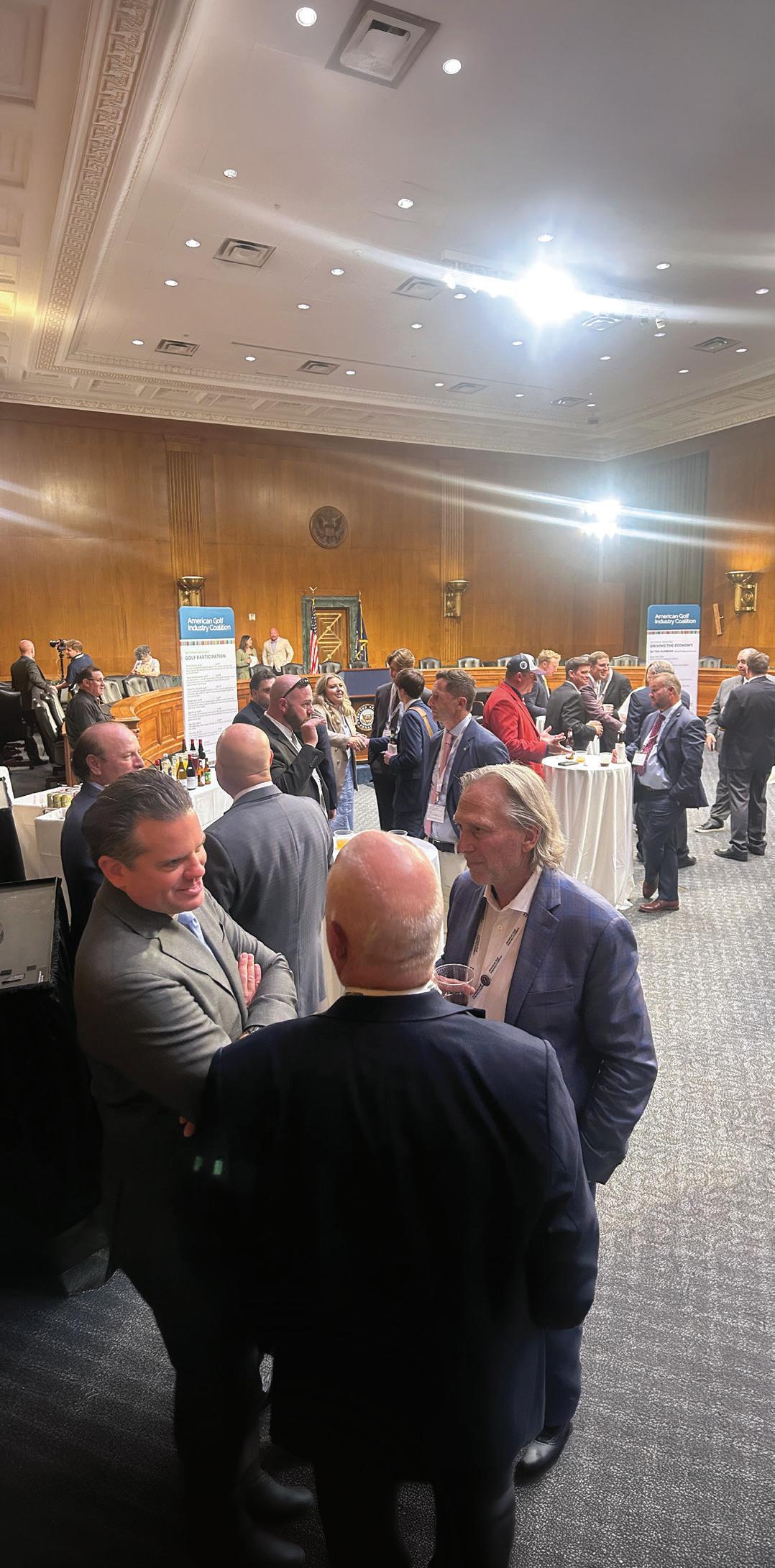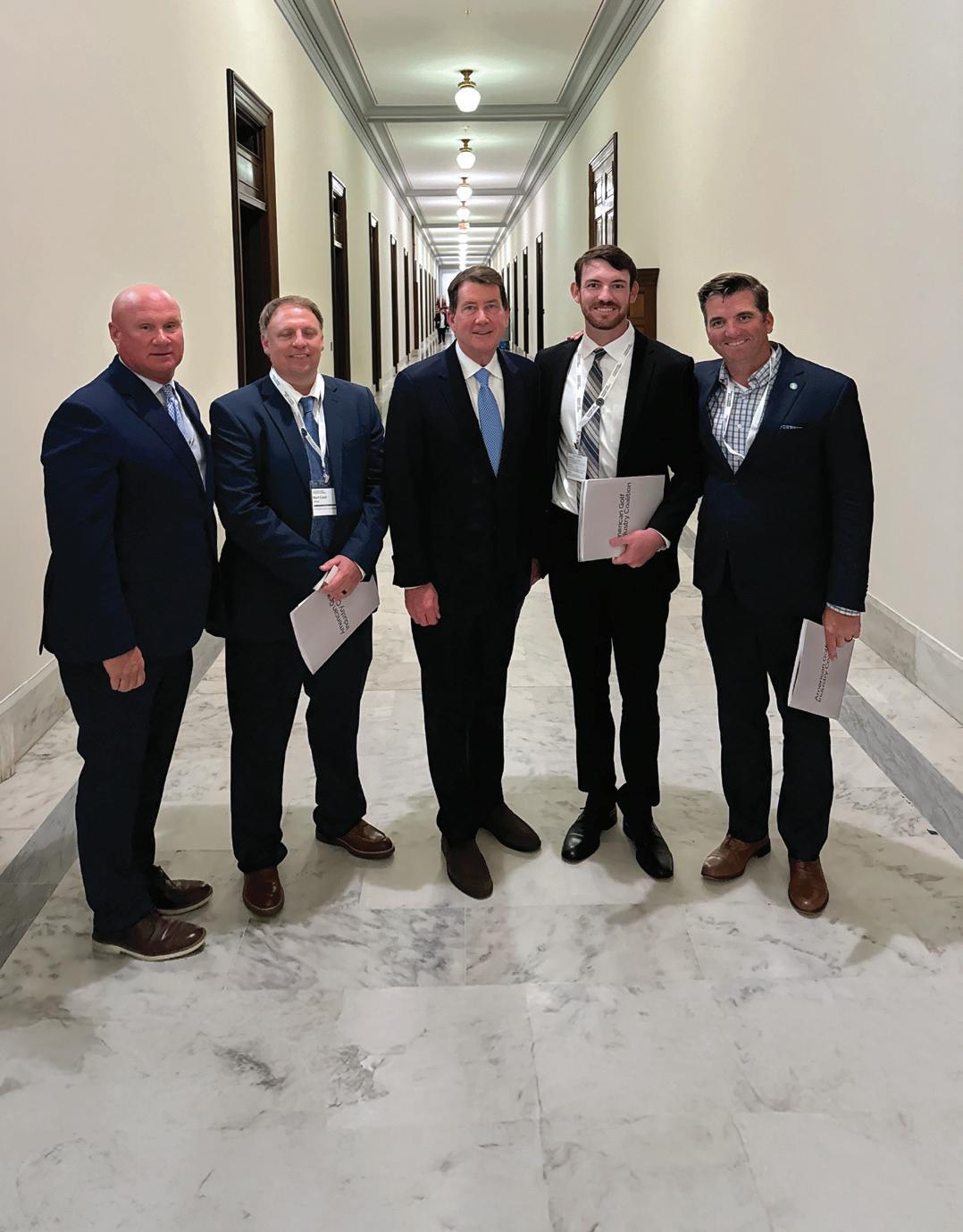
7 minute read
Feature
National Golf Day
By Grayson Guthrie 1st Assistant Superintendent
The Governors Club (615) 351-0610
gguthrie@thegovernorsclub.net
I had the unique and enriching opportunity to attend National Golf Day in Washington, D.C., a professional experience that blended advocacy, community service, and a shared passion for the game of golf. This trip was more than just a chance to speak to elected officials or participate in a community service project on golf courses—it was a chance to see firsthand how deeply interwoven golf is with legislation, economics, public health, and environmental stewardship. Across three eventful days, I was able to represent not only the interests of golf professionals and enthusiasts in my state but also contribute to the positive perception of golf as a force for good in communities across the country.
The trip began with the National Golf Day opening ceremony which set the tone for the entire week and brought together professionals from all corners of the golf industry—course superintendents, PGA professionals, association executives, and business owners alike. One of the highlights of the evening was the keynote speaker, Jake Sherman, one of the founders of Punchbowl News. It was a fascinating and relevant address; Punchbowl News has emerged as a critical player in political journalism and understanding the legislative process. Sherman provided insight into the current political climate, the inner workings of Congress, and how advocacy can make a difference—even in an oftengridlocked environment.

This was followed by a detailed discussion of the key talking points we would be addressing in our meetings with lawmakers. These issues were not only relevant to golf as a sport but also to golf as an industry that supports millions of jobs and contributes $102 billion annually to the national economy. We were briefed on topics ranging from taxation and disaster relief to healthcare and research funding. While I was already familiar with some of the topics, hearing the perspectives of policy experts helped me better understand how to frame our arguments in a way that would resonate with legislators and their staff.
The next day, our schedule was packed with meetings on Capitol Hill. We had meaningful discussions with the legislative assistants of Senator Bill Hagerty, Senator Marsha Blackburn, Representative Mark Green, Representative Scott DesJarlais, Representative Chuck Fleischmann, and Representative Andy Ogles. A major point of discussion during these conversations was the “sin tax” designation that golf courses currently fall under. This classification categorizes golf facilities alongside gambling and alcohol-related businesses, which prevents them from receiving federal disaster relief funds. As recent natural disasters have shown, golf courses are just as vulnerable to hurricanes, floods, and wildfires as any other business or community institution. Yet, due to this outdated classification, they are often excluded from critical support. This puts not only the facilities but also their employees and local economies at risk, given golf’s impact on local tourism, environmental management, and the physical health of its patrons.

Another significant topic was the Farm Bill, particularly the inclusion of the Turfgrass Research Initiative. With turf comprising 60+ million acres and being the 4th largest crop in the United States, this federal investment is vital for the continued sustainability and innovation within turfgrass science.
Golf courses are among the largest managed green spaces in the United States, and they play an important role in water conservation, soil health, and urban cooling. Funding turfgrass research enables golf facilities to improve their practices, reduce water and chemical use, and adopt more environmentally sustainable techniques. In other words, this is not just a golf issue—it’s an environmental one that intersects with agriculture, land use, and climate resilience.
We also addressed the PHIT Act, or the Personal Health Investment Today Act, which proposes allowing individuals to use Health Savings Accounts (HSAs) and Flexible Spending Accounts (FSAs) toward physical activity expenses, including golf. This proposal is rooted in a growing understanding that preventative health care—exercise, active lifestyles, and community wellness—is essential to reducing longterm healthcare costs. We presented golf not just as a sport or hobby, but as an accessible form of exercise that contributes to physical and mental well-being for people of all ages.
Other topics included workforce development in the golf industry, access to green spaces for underserved communities, and the broader economic impact of golf in our region. Throughout the day, I was struck by how receptive and engaged the legislative staff were. Even if they didn’t have prior experience with golf policy, they asked thoughtful questions and took detailed notes. It reminded me that advocacy works when it’s based on facts, empathy, and a clear connection between public policy and everyday lives.
After a full day of advocacy, the last day of our trip was a welcome shift in pace and focus. We participated in a community service project that took place at two of Washington D.C.’s public golf courses: the Old Soldiers’ Home Golf Course and East Potomac Golf Course. This allowed us to put our mission into practice. While policy discussions are vital, so too is the visible commitment to improving and preserving the spaces where golf happens.

The work was hands-on and satisfying–we mowed greens and fairways, seeded putting surfaces, planted trees, and detailed flower beds with fresh mulch.
Working alongside volunteers from across the country created a strong sense of camaraderie. It was a physical reminder that we’re all in this together—not just talking about change, but making it happen with our own hands. The restoration and beautification efforts we made at these historic courses not only benefit the players who use them but also preserve green space in a major metropolitan area. It’s a demonstration of golf’s potential to provide refuge, especially in urban settings.

Throughout the three days, I gained a deeper appreciation for the complexity and scope of the golf industry. Golf can be seen as a leisure activity or a luxury pursuit, but this trip reinforced just how much more it is. Golf touches issues of public health, environmental sustainability, economic development, youth engagement, and community identity.
Whether we were advocating for fair disaster relief policies or planting trees on public courses, the unifying theme was that golf has the potential to be a force for social good.
A lasting impression from the trip is the power of unity. The National Golf Day coalition represents a variety of roles and organizations, but we spoke with one voice. We weren’t just advocating for our own jobs or facilities—we were advocating for the future of the game, and for its benefits to people and communities across the nation. That sense of shared purpose made the whole experience more powerful and meaningful.
In reflection, this trip was not only a career highlight, but also a reminder of the importance of civic engagement. Too often, people feel disconnected from the political process, or assume that their voices won’t matter.
But by showing up, making our case, and following up, we are shaping the future of golf and influencing the policies that affect our industry. Even the conversations with legislative assistants, which some might overlook, are crucial touchpoints in the legislative process. Those relationships matter. The clarity of our message matters.
Moving forward, I hope to build on this experience by staying active in advocacy efforts—at both the state and national levels. I plan to share what I learned with colleagues and encourage others in the golf industry to get involved. Whether it’s attending town halls, engaging with local representatives, or participating in community clean-up efforts, we all have a role to play.

In conclusion, National Golf Day in Washington, D.C. was far more than a work trip. It was an opportunity to advocate for meaningful policy change, engage in service, and elevate the role golf can play in American life. I am grateful for the opportunity that the Golf Course Superintendents Association of America, the American Golf Industry Coalition, and the Tennessee Turfgrass Association provided, and I am energized to continue this important work.









